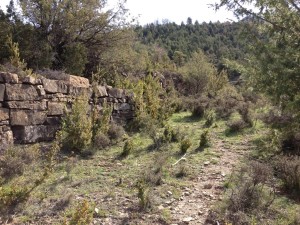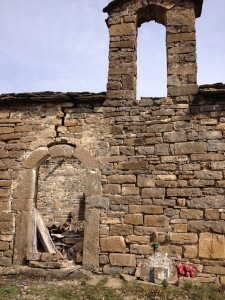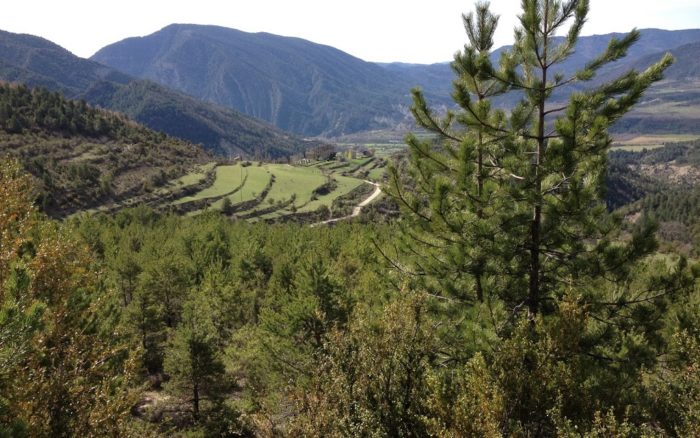“Wild is what happened when white man arrived,” I once heard Native American scholar Greg Sarris say. Today as I walk these ancient Spanish paths that interlace several remote, abandoned villages throughout the southern Pyrenees of the Sobarbre area, I broaden the statement: wild is what too often happens when a people who have loved and lived on a land for centuries, leave.
The paths I walk are along stone-walled terraces, work done over centuries by mountain people who lived here since perhaps the 12th century. For centuries these terraces were used to graze livestock and grow cereal grains, but now pines are planted in rows, usually two rows to a terrace, and thorny bushes fill in between.
There is a convergence of reasons the mountain people left. In the 1950’s there were no jobs for the young women, so after the women went to the cities to become maids, for village people lacked education and these were the jobs open to them, the young men followed, becoming taxi cab drivers. This left the older people with the rigors of mountain farming. When the government offered to buy their villages, they took them up on it and within two or three years 14 villages in this area alone were abandoned, 400 villages in all of Spain.
But another story tells of how a threatened hydroelectric project which never came to fruition also pushed these people’s decisions to leave. One story tells how in preparation, the government planted small pine trees on the terraces to control erosion should the hydroelectric project go through, which made it impossible to use the terraces to graze cattle. Another story tells how the people feared even more isolation if the project did happen. There were no roads into these small villages. After they were abandoned, roads were made, mainly for firebreaks. Some say these independent people also wisely feared political reprisals.
 |
| A terrace with a stone retaining wall. Now the terrace is the path and scrubby plants and pines grow. |
The land is quiet today, the pine trees insuring that mountain way of life to be over. I would never suggest returning to that life. It is clear that the remoteness made for hardship and lack of what we consider essential: education, medical care, modern conveniences.
But there were positives: the rigors of the environment and harshness of the climate demanded that these people know the land in all its moods, as well as work with each other and with other villages for the welfare of all. They cooperated, at least enough of the time, so every one got his or her fair share. The elements forced it.
 |
| Church in Puyuelo and Memorial to a Native. |
In the silence of the village I cannot help but wonder: Where are your people now? How did they recover from leaving land their families had farmed for centuries?
Walking between these pines, I wonder: what about land that has lost its people who knew it best? Those terraces so important for farming and erosion control crumble in places the road nicked the stone walls or changed drainage.
And why pines? Although they are native, I am told that this side of the mountain is drier, making pines a fire hazard. Oaks are the trees that grow naturally on this side. In what way was that decision made? Probably not by consulting the mountain people! If humans are going to make such huge changes, may we also realize we need to know the land intimately, and the people as well, to anticipate unintended consequences. In the words of forester Aldo Leopold, “…man-made changes are of a different order than evolutionary changes, and have effects more comprehensive than is intended or foreseen (A Sand County Almanac, 255).”
Today in entering the village of Puyuelo, I came upon a memorial stone at the ransacked church, a stone I assumed was for a man born and raised there. He died in 2010, born in 1924. His name and birth and death dates were followed by “D.E.P.”, rest in peace. Only in death could he return home.
I felt a wave a grief as I continued down the village path to a large flowering pear tree next to a crumbling home, and then the stone-walled path leading on to another abandoned village below.
This village knew care from its people and its people were a people who knew their place in the whole of the area, both in its environmental needs and in the social benefits of cooperation with other neighbors. I can only wonder what this sudden evacuation and abandonment can mean both to those who were compelled to leave and to the beloved land from which they departed.
